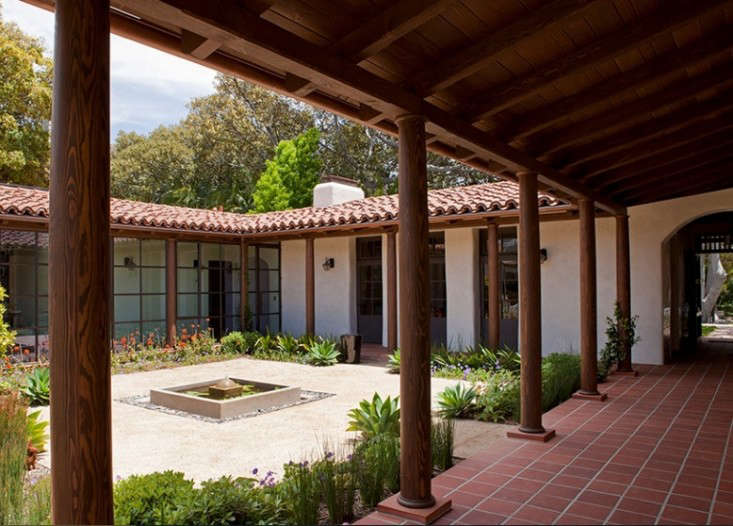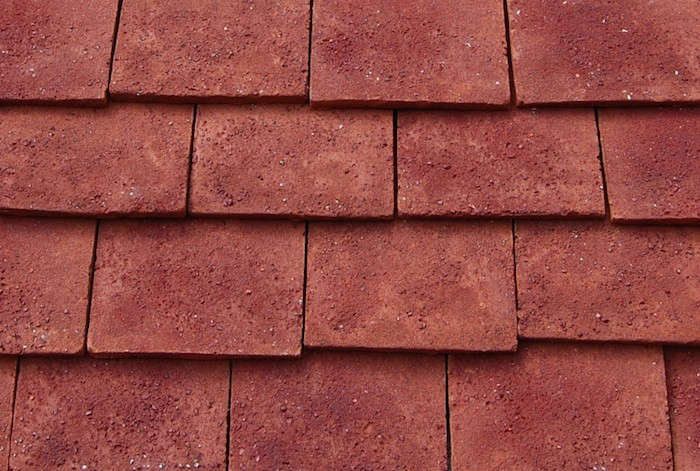I still remember the first time I saw roofs made of red clay tiles. I was visiting my grandmother in Santa Monica one hot summer, and I was enchanted by the city’s combination of terra-cotta roofs, stucco bungalows, cracked concrete streets, and tall, skinny palm trees. Santa Monica seemed warm and gracious, and those tile roofs evoked a feeling of permanence and craftsmanship. And in fact, as I’ve since learned, they actually are permanent. With care, a tile roof will last forever.
Besides their longevity, clay roof tiles are also insulating and fireproof. What’s more, they can be reused and recycled. Why don’t we see them everywhere?

What is the history of clay roof tiles?
Clay roof tiles date to the ancient Persian and Mesopotamian cultures. Prized for their ability to withstand the elements and resist rot, they have been used for centuries throughout Europe and Asia. After European settlers brought the craft of tile-making to North America, clay tiles started to appear on the roofs of Jamestown, Roanoke, and St. Augustine. By the mid-1600s, building codes in New York, Boston, and other cities encouraged the use of clay tiles due to their fireproof properties.

How are clay roof tiles made?
Terra-cotta is Italian for “baked earth,” which is a fairly accurate description. Most manufacturers extract clay from a nearby quarry, press it into molds, and fire the tiles at high temperatures. Tiles can be glazed or treated to withstand freezing or excessive heat. Check with your roofing contractor to make sure you’re choosing the right type for your climate.

What colors and styles of clay tiles are available?
Historically, tiles were the color of whatever clay deposit was nearby, ranging from buff to reddish brown. These days there’s a wider variety of colors, but earth tones still predominate. They may be uniform or have a range of color within each tile.

Styles are defined by the shape: rounded, flat, or ridged. The familiar Spanish tile is the rounded “barrel” tile; the flat English style might be mistaken for another material if not for its ruddy hue.


What kind of house looks good with clay tiles?
Americans tend to associate a clay roof with Spanish or Italian stucco architecture. But the wide selection of shapes makes clay tile suitable for many architectural styles. It pairs well with stucco, stone, or brick siding. Flat tiles work particularly well with wood siding, and in both traditional and modern forms.
Note: Slope is an important consideration when planning a clay roof. Typically, clay roofs are only used for roofs sloped from 20 to 50 degrees.


What maintenance does clay roof tile need?
Clay roof tiles are durable and long-lasting–manufacturers often give warranties of anywhere from 50 to 100 years. That means the tiles can last longer than the house they’re covering, but there are issues to keep in mind. For one thing, the material beneath the tiles must be able to support the weight of the clay tiles, and often needs to be waterproof. To last as long as the tiles, flashing should be lead or copper. In a clay tile roof, leaks are generally caused not by broken tiles, but by substandard or incorrectly installed flashing or metal fasteners underneath.
While its insulating properties make it an ideal choice for hot climates, a tile roof can also perform well in snow country, as long as the structure is engineered to support the weight of both clay and snow.
Clay roof tiles never should be walked upon–they can break. Luckily, if a tile does break you can replace it individually. It’s not a complex job, but you should hire a professional to do it. And obviously, the repair will match better if you have extra tiles saved from the installation.

How much does clay roof tile cost?
For a new clay roof, let’s just say that the adage “Buy quality and you only cry once” applies. Professional installation can cost from $12,000 to $25,000, depending on the size and pitch of your roof. Higher-end tiles can push the price to $70,000, plus the cost of extra structural support if needed.

Where can I buy clay roof tiles?
Manufacturers in the US include: Verea Tile (based in Florida); Ludowici Roof Tile (Ohio); MCA (California); Boral Roofing (Georgia) Gladding, McBean (California), and Santafé Tile (Southwest). Spain’s Tejas Borja exports clay tiles all over the world, and has a US distributor in the Northeast Tri-state area.
Another desirable option: reclaimed tiles, often available from roofing installation companies, salvage yards, or through Craigslist. San Francisco-based Cooritalia specializes in Spanish, Italian, and French reclaimed clay roof tile (they also offer new Roman barrel tiles).

Clay Tile Roof Recap
Pros:
- Sustainable–clay is a natural substance and tiles can be reused
- Lasts forever
- Excellent insulator
- Protects against rot and insect damage
- Fireproof
Cons:
- Expensive
- Can break if walked on
- Heavy; can need extra structural support
- Underlying material sometimes needs to be replaced
- Limited aesthetically
Researching roofing material options? See our earlier features:
- Hardscaping 101: Standing Seam Metal Roofs.
- Hardscaping 101: Green Roofs.
- Hardscaping 101: Asphalt Shingles.
For a fun addition to your clay tile roof, Michelle found a Roof Tile for the Birds.












Have a Question or Comment About This Post?
Join the conversation (2)